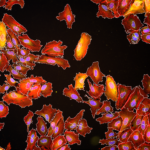Lien vers Pubmed [PMID] – 15793109
Antimicrob. Agents Chemother. 2005 Apr;49(4):1340-5
The activities of short synthetic, nonhemolytic peptides derived from the C-terminal region of myotoxin II, a catalytically inactive phospholipase A2 homologue present in the venom of the snake Bothrops asper, have been shown to reproduce the bactericidal activity of the parent protein. They combine cationic and hydrophobic-aromatic amino acids, thus functionally resembling the antimicrobial peptides of innate defenses. This study evaluated the antimicrobial and antiendotoxic properties of a 13-mer derivative peptide of the C-terminal sequence from positions 115 to 129 of myotoxin II, named pEM-2. This peptide (KKWRWWLKALAKK) showed bactericidal activity against both gram-positive and gram-negative bacteria. In comparison to previously described peptide variants derived from myotoxin II, the toxicity of pEM-2 toward eukaryotic cells in culture was significantly reduced, being similar to that of lactoferricin B but lower than that of polymyxin B. The all-D enantiomer of pEM-2 [pEM-2 (D)] retained the same bactericidal potency of its L-enantiomeric counterpart, but it showed an enhanced ability to counteract the lethal activity of an intraperitoneal lipopolysaccharide challenge in mice, which correlated with a significant reduction of the serum tumor necrosis factor alpha levels triggered by this endotoxin. Lethality induced by intraperitoneal infection of mice with Escherichia coli or Salmonella enterica serovar Typhimurium was reduced by the administration of pEM-2 (D). These results demonstrate that phospholipase A2-derived peptides may have the potential to counteract microbial infections and encourage further evaluations of their actions in vivo.

